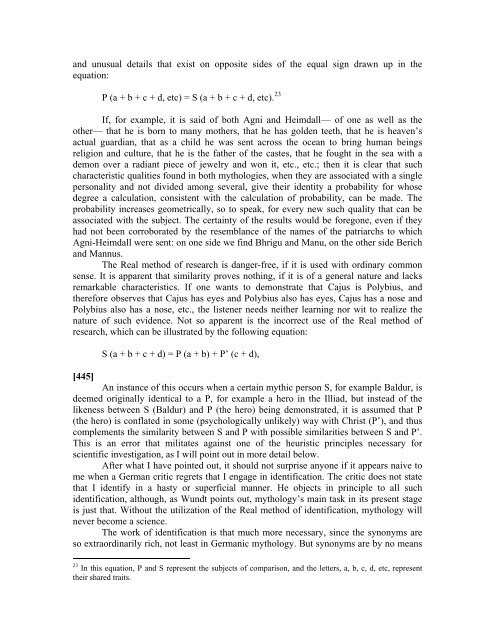Towards a Method of Mythology - Germanic Mythology
Towards a Method of Mythology - Germanic Mythology
Towards a Method of Mythology - Germanic Mythology
Create successful ePaper yourself
Turn your PDF publications into a flip-book with our unique Google optimized e-Paper software.
and unusual details that exist on opposite sides <strong>of</strong> the equal sign drawn up in the<br />
equation:<br />
P (a + b + c + d, etc) = S (a + b + c + d, etc). 23<br />
If, for example, it is said <strong>of</strong> both Agni and Heimdall— <strong>of</strong> one as well as the<br />
other— that he is born to many mothers, that he has golden teeth, that he is heaven’s<br />
actual guardian, that as a child he was sent across the ocean to bring human beings<br />
religion and culture, that he is the father <strong>of</strong> the castes, that he fought in the sea with a<br />
demon over a radiant piece <strong>of</strong> jewelry and won it, etc., etc.; then it is clear that such<br />
characteristic qualities found in both mythologies, when they are associated with a single<br />
personality and not divided among several, give their identity a probability for whose<br />
degree a calculation, consistent with the calculation <strong>of</strong> probability, can be made. The<br />
probability increases geometrically, so to speak, for every new such quality that can be<br />
associated with the subject. The certainty <strong>of</strong> the results would be foregone, even if they<br />
had not been corroborated by the resemblance <strong>of</strong> the names <strong>of</strong> the patriarchs to which<br />
Agni-Heimdall were sent: on one side we find Bhrigu and Manu, on the other side Berich<br />
and Mannus.<br />
The Real method <strong>of</strong> research is danger-free, if it is used with ordinary common<br />
sense. It is apparent that similarity proves nothing, if it is <strong>of</strong> a general nature and lacks<br />
remarkable characteristics. If one wants to demonstrate that Cajus is Polybius, and<br />
therefore observes that Cajus has eyes and Polybius also has eyes, Cajus has a nose and<br />
Polybius also has a nose, etc., the listener needs neither learning nor wit to realize the<br />
nature <strong>of</strong> such evidence. Not so apparent is the incorrect use <strong>of</strong> the Real method <strong>of</strong><br />
research, which can be illustrated by the following equation:<br />
S (a + b + c + d) = P (a + b) + P’ (c + d),<br />
[445]<br />
An instance <strong>of</strong> this occurs when a certain mythic person S, for example Baldur, is<br />
deemed originally identical to a P, for example a hero in the Illiad, but instead <strong>of</strong> the<br />
likeness between S (Baldur) and P (the hero) being demonstrated, it is assumed that P<br />
(the hero) is conflated in some (psychologically unlikely) way with Christ (P’), and thus<br />
complements the similarity between S and P with possible similarities between S and P’.<br />
This is an error that militates against one <strong>of</strong> the heuristic principles necessary for<br />
scientific investigation, as I will point out in more detail below.<br />
After what I have pointed out, it should not surprise anyone if it appears naive to<br />
me when a German critic regrets that I engage in identification. The critic does not state<br />
that I identify in a hasty or superficial manner. He objects in principle to all such<br />
identification, although, as Wundt points out, mythology’s main task in its present stage<br />
is just that. Without the utilization <strong>of</strong> the Real method <strong>of</strong> identification, mythology will<br />
never become a science.<br />
The work <strong>of</strong> identification is that much more necessary, since the synonyms are<br />
so extraordinarily rich, not least in <strong>Germanic</strong> mythology. But synonyms are by no means<br />
23 In this equation, P and S represent the subjects <strong>of</strong> comparison, and the letters, a, b, c, d, etc, represent<br />
their shared traits.
















